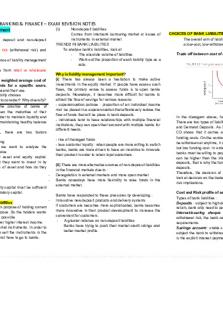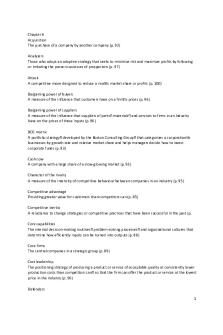Exam Revision Notes PDF

| Title | Exam Revision Notes |
|---|---|
| Course | Concomitant Strabismus and Visual Development |
| Institution | Glasgow Caledonian University |
| Pages | 6 |
| File Size | 156.5 KB |
| File Type | |
| Total Downloads | 73 |
| Total Views | 153 |
Summary
Just a simple summary of all the lectures covered....
Description
A 17 year old student presents complaining of headaches and blurred vision when reading for long periods. They are most likely to have: A. Esophoria – Convergence Excess B. Exophoria – Divergence Excess The patient could be hypermetropic, they could have very slight latent hypermetropia. But we don’t know that. What we do know that is if someone has an esophoria that is much bigger at near than in the distance, then its highly likely that they have a high AC/A ratio. Having an AC/A ratio that is higher than normal really has nothing to do with hypermetropia. You can either have a high level of hypermetropia and still have slight AC/A ratio or you can have a completely normal level of ametropia, and still have a high AC/A ratio. So anybody who has an eso deviation that is significantly larger at near, remember, an esophoria of Convergence Excess must be 10^D greater at near than it is in distance. That implies they have a high AC/A ratio. So for example in the exam qns, we will be looking for you to go and measure the AC/A ratio.
Bagolini Glasses • • • • • • • •
Striations are placed at 45 and 135 degrees angle Detects suppression Checks for bifoveal fixation Partially dissociative Test for sensory fusion 5 different result responses Able to check for microtropia Able to use as a means of control when measuring prism fusion range
AC/A Ratio •
• • • •
•
2 methods of measuring: 1) Gradient method: (PCT w lens – PCT w/o lens)/lens strength 2) Amount of convergence exerted per dioptre of accommodation Normal: 3-5:1 Lens strength: +3.00D @ Near are used to relax accommodation OR -3.00D @ Distance Preferred method testing for child is purely at near because its much easier to relax someone’s accommodation than be 100% sure that when they are looking at the 6m target that are reading the very small line and reading it clearly then we know they are fully accommodating. So its much easier to relax accommodation than to exert accommodation. Near Target: Small detailed picture / Snellen chart on a bungee stick
DVD is associated with: A. B. C. D.
Microtropia Infantile esotropia Double elevator palsy Brown’s Syndrome
Give all the features of a pseudosquint: Pseudosquint in babies are extremely common!
Babies don’t get fully accommodative Esotropia!
- Straight eyes - Corneal reflections sitting centrally - Symmetrical corneal reflections - No deviations on cover test to an accommodative target or in the distance - Full ocular motility - No other signs and symptoms - Negative family hx of squint or refractive error - Have broad epicanthic folds
How do we measure how well compensated a heterophoria is? A. Prism Cover Test B. Prism Adaptation Test C. Fusional reserves with prism (Prism Fusion Range)
Fully Accommodative Esotropia • •
• • •
Moderate hypermetropes (+2 → +5/6) BSV for all distances with glasses on (so when that px is wearing their glasses, they have normal retinal correspondence (NRC), have normal BSV, and eyes are working beautifully. SO they should have sensory fusion, motor fusion and stereopsis working at perfectly normal levels. So 55seconds of arc and above for stereoacuity, good fusion range for near and distance. May have minimal eso or exophoria wearing the glasses). If they are fully corrected, they should be able to control that deviation. If they still have a some eso deviation with their glasses on, then I would be requesting that the patient have a further full cycloplegic refraction → maybe hypermetropia is undercorrected. If they have a small exophoria then we might have given them abit too much plus Considered an intermittent form of strabismus (because when glasses are on there’s no squint but when glasses are removed, px will have an esotropia) Most often the esotropia tend to be alternating so they don’t tend to have amblyopia Possible to have a Fully accommodative esotropia with a microtropia (refractive correction for this patient will then be they are hypermetropic but they also have a degree of anisometropia)
A normal Fully Accommodative Esotropia is going to be a hypermetrope with a moderate degree. Straight with glasses on, squint with glasses off. Don’t tend to have amblyopia unless they also have anisometropia in which case they may have anisometropia and microtropia when the glasses are on and a large angle of esotropia when the glasses are off.
Distance Exotropia • • • • • • •
BSV for near, squinting in the distance Deviation greater in the distance Can have a high AC/A ratio if it’s a Simulated type Can also have a simulated type controlled by fusion Mostly females Presents when child is at school or nursery Ddx between true OR simulated type
Near Esotropia • • • • • • •
Esotropia that’s greater at near with BSV in the distance Ddx from convergence excess esotropia Normal AC/A ratio and yet it still has a large angle of esotropia at near Esophoria or straight eyes in the distance Don’t tend to have a refractive correction so they don’t tend to be hypermetropes No accommodative element Thought to be related to proximal convergence
Management: Going to weaken both MR, won’t give prisms because near esotropia is something generally presented during childhood and we don’t give prisms because that will reduce visual acuity and in turn give them amblyopia. And if you have a large angle of esotropia, you’re going to need a lot of prisms in order to get the px straight, so yes, you could say in temporary situation, you could give them a prism in order for them to be binocular for near and distance but they will be listed for surgery because they are not able to be corrected optically or with prisms for any long term. SO surgery is absolutely the answer for that.
Which of the following statements on microtropia WITHOUT identity is true? A. B. C. D.
The angle of strabismus does not coincide with the angle of eccentric fixation There is no movement of the strabismic eye to take up fixation on cover-uncover test Binocular vision is not possible There is no eccentric fixation
Microtropia Without Identity: • • •
Small manifest deviation so there would be a movement No eccentric point Manifest deviation of...
Similar Free PDFs

Exam revision notes - useful
- 20 Pages

EIM-Exam-Revision-Notes
- 22 Pages

Exam Revision Notes
- 6 Pages

Revision wills - Exam notes
- 17 Pages

HAP Final Exam Revision Notes
- 64 Pages

EXAM Revision
- 56 Pages

EXAM Revision
- 25 Pages

Revision Notes
- 58 Pages

Revision Notes
- 20 Pages

Revision Notes
- 32 Pages

Revision Notes
- 16 Pages

Revision Notes
- 35 Pages

Exam revision - Lecture notes 3, 4
- 14 Pages
Popular Institutions
- Tinajero National High School - Annex
- Politeknik Caltex Riau
- Yokohama City University
- SGT University
- University of Al-Qadisiyah
- Divine Word College of Vigan
- Techniek College Rotterdam
- Universidade de Santiago
- Universiti Teknologi MARA Cawangan Johor Kampus Pasir Gudang
- Poltekkes Kemenkes Yogyakarta
- Baguio City National High School
- Colegio san marcos
- preparatoria uno
- Centro de Bachillerato Tecnológico Industrial y de Servicios No. 107
- Dalian Maritime University
- Quang Trung Secondary School
- Colegio Tecnológico en Informática
- Corporación Regional de Educación Superior
- Grupo CEDVA
- Dar Al Uloom University
- Centro de Estudios Preuniversitarios de la Universidad Nacional de Ingeniería
- 上智大学
- Aakash International School, Nuna Majara
- San Felipe Neri Catholic School
- Kang Chiao International School - New Taipei City
- Misamis Occidental National High School
- Institución Educativa Escuela Normal Juan Ladrilleros
- Kolehiyo ng Pantukan
- Batanes State College
- Instituto Continental
- Sekolah Menengah Kejuruan Kesehatan Kaltara (Tarakan)
- Colegio de La Inmaculada Concepcion - Cebu


